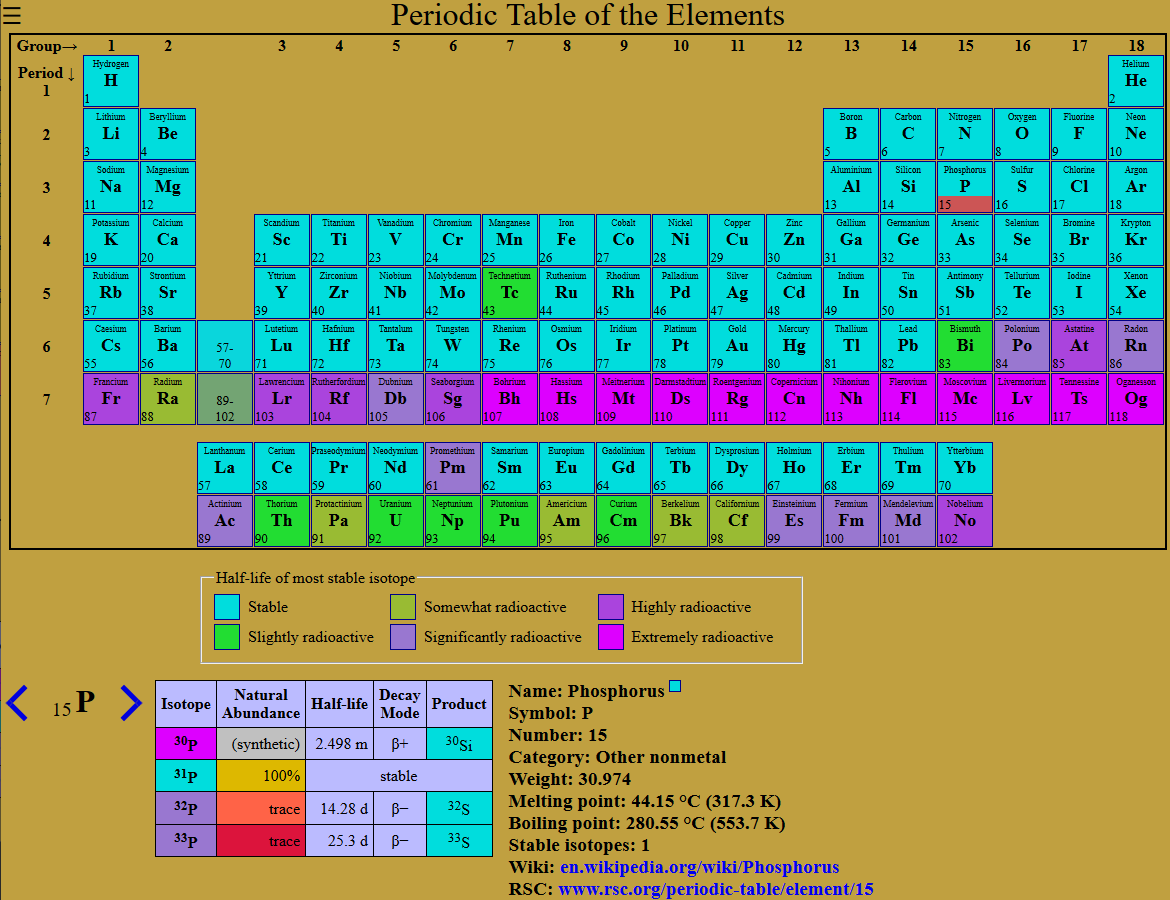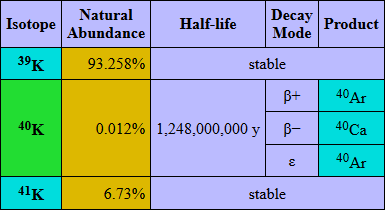The KaosPhysics project started with the elements.html page - an
interactive and internationalized periodic table of the elements.
It became necessary to model the required data in a strongly typed environment so C# was chosen.
This .NET codebase generates JSON for the nuclides table and HTML for the tables themselves.
The term nuclides is used for the elements structure because it includes the neutron at index 0, followed by hydrogen, etc. This allows using an element's atomic number (proton count) as the array index.
The elements.html file is an HTML/CSS/JavaScript page that:
- Displays the periodic table of the elements in standard form, 32-column (long) form, or left-step form.
- Provides a plethora of switchable themes.
- Provides an element browser with isotope details.
- Provides full support for many languages, including 3 English variants.
- Detects language on page load for best-fit initial setting.
- Uses responsive CSS to provide adaptable output without JavaScript.
- Is only a single file with no dependencies for ease of distribution and offline functionality.
Here is a dark mode screenshot of the Stability theme in standard form with phosphorus selected:
Bring up the app menu to select language, theme, table form, and more by tapping the hamburger icon at top left.
The latest version of Elements is posted here:
https://kaosborn.github.io/elements.html
Work is ongoing in these areas:
- Adding categories.
- Improving user interface.
- Improving current translations, adding more languages (nl, pl, pt, ?).
The DotGenJson folder contains a .NET project that builds DotGenJson.exe
for generating JSON data sourced from the KaosPhysics model.
This JSON object:
- Provides detailed nuclide and isotope information.
- Provides translations to de, en, en-GB, en-US, es, fr, it, ru:
- Element names
- Decay mode names
- Category names
- Names of states of matter
- And more
See the object here:
https://kaosborn.github.io/data/kaosNuclides.json
The Elements web page (above) uses this object to produce its content.
For example,
the following potassium isotopes table is built dynamically from data emitted by DotGenJson.exe:
(See the original page at kaosborn.github.io/elements.html?theme=stab;z=19)
Usage: DotGenJson.exe [-js]
- Use the
-jsswitch to emit JavaScript rather than JSON.
The DotElements folder contains a .NET project that builds DotElements.exe
for generating concise, human readable data sourced from the KaosPhysics model.
This program produces a narrow, fixed-width listing of the elements
followed by fixed-width listings of their isotopes.
For output of the default (world-English), see here:
https://kaosborn.github.io/data/kaosNuclides-en.txt
Usage: DotElements.exe [languageCode]
- Provide a language argument (2 or 5 characters) for translations of chemical terms.
This folder builds a class library of KaosPhysics in the form of a .nuget package.
Another way to consume KaosPhysics is to include the source by using a shared project reference.
The executables presented here use the latter method.
This folder contains the C# source to the KaosPhysics model in a shared project.
This library source defines the Kaos.Physics namespace with 2 classes:
- The
Nuclideclass which consists of the neutron followed by the elements. - The
Isotopeclass which is referenced by theNuclideclass.
See the files Nuclide.cs and Isotope.cs here:
https://github.com/kaosborn/KaosPhysics/tree/master/Source/KaosPhysics
This folder contains a MSTest project that ensures the nuclides table hasn't gotten totally munged.
Here is an excerpt of the JSON emitted by DotGenJson.exe:
"nuclides": [
{ "z": 0, "symbol": "n", "period": 0, "group": 0, "categoryIndex": 7, "block": " ", "occurrenceIndex": 1, "lifeIndex": 0, "discoveryYear": 1932, "discoveryIndex": 4, "stateIndex": 0, "melt": null, "boil": null, "weight": 1.000, "stableCount": 0, "stabilityIndex": 4, "isotopes": [{"z":0,"a":1,"abundance":0,"occurrenceIndex":1,"stabilityIndex":4,"decayFlags":4,"halflife":610.1,"timeUnit":"s"}] },
{ "z": 1, "symbol": "H", "period": 1, "group": 1, "categoryIndex": 7, "block": "s", "occurrenceIndex": 3, "lifeIndex": 1, "discoveryYear": 1766, "discoveryIndex": 1, "stateIndex": 3, "melt": 13.990, "boil": 20.271, "weight": 1.008, "stableCount": 2, "stabilityIndex": 0, "isotopes": [{"z":1,"a":1,"abundance":99.985,"occurrenceIndex":3}, {"z":1,"a":2,"abundance":0.015,"occurrenceIndex":3}, {"z":1,"a":3,"abundance":0,"occurrenceIndex":1,"stabilityIndex":3,"decayFlags":4,"halflife":12.32,"timeUnit":"y"}] },
{ "z": 2, "symbol": "He", "period": 1, "group":18, "categoryIndex": 9, "block": "s", "occurrenceIndex": 3, "lifeIndex": 0, "discoveryYear": 1868, "discoveryIndex": 2, "stateIndex": 3, "melt": 0.950, "boil": 4.222, "weight": 4.003, "stableCount": 2, "stabilityIndex": 0, "isotopes": [{"z":2,"a":3,"abundance":0.0002,"occurrenceIndex":3}, {"z":2,"a":4,"abundance":99.9998,"occurrenceIndex":3}] },
{ "z": 3, "symbol": "Li", "period": 2, "group": 1, "categoryIndex": 0, "block": "s", "occurrenceIndex": 3, "lifeIndex": 2, "discoveryYear": 1817, "discoveryIndex": 2, "stateIndex": 1, "melt": 453.650, "boil": 1603.000, "weight": 6.940, "stableCount": 2, "stabilityIndex": 0, "isotopes": [{"z":3,"a":6,"abundance":7.59,"occurrenceIndex":3}, {"z":3,"a":7,"abundance":92.41,"occurrenceIndex":3}] }
]Access the chemical elements by indexing the above nuclides array by atomic number.
Element names are stored separately in nuclideNames for language selection.
Next is a trimmed excerpt of that object:
"nuclideNames": {
"de" : [ "Neutron", "Wasserstoff", "Helium", "Lithium", "..." ],
"en" : [ "Neutron", "Hydrogen", "Helium", "Lithium", "..." ],
"en-gb": [ "Neutron", "Hydrogen", "Helium", "Lithium", "..." ],
"en-us": [ "Neutron", "Hydrogen", "Helium", "Lithium", "..." ],
"es" : [ "Neutrón", "Hidrógeno", "Helio", "Litio", "..." ],
"fr" : [ "Neutron", "Hydrogène", "Hélium", "Lithium", "..." ],
"it" : [ "Neutrone", "Hydrogène", "Elio", "Litio", "..." ],
"ru" : [ "Водород", "Нейтрон", "Гелий", "Литий", "..." ]
}Here is a JavaScript example that shows the symbol for Z=2 followed by its name in Spain.
console.log ("Symbol = " + nuclides[2].symbol);
console.log ("Name in Spain = " + nuclideNames["es"][2]);Console output:
Symbol = He
Name in Spain = Helio
Keys in the nuclides object named with the suffix of Index require a lookup in another object.
Corresponding lookup tables are provided with language translations.
The isotopes arrays vary in length depending on isotope radioactivity:
- Stable isotopes
- Neutron count (A)
- Natural abundance percentage
- Natural occurrence index
- Radioactive isotopes include 4 more values
- Stability index
- Decay mode bitflags
- Half-life
- Half-life time unit
See tritium (Z=1, A=3) for an example of a radioactive isotope.
The source for the JSON data above is the KaosPhysics C# shared project. Here is an excerpt of a constructor:
public static Nuclide Hydrogen { get; } = new Nuclide
(
z: 1, symbol: "H", name: nameof (Hydrogen),
category: Category.Nonmetal,
period: 1, group: 1,
melt: 13.99, boil: 20.271,
weight: 1.008,
life: Nutrition.BulkEssential,
known: 1766, credit: "Henry Cavindish",
naming: "From Greek, meaning water-former",
isotopes: new Isotope[] { new Isotope (1, 1, 99.985), new Isotope (1, 2, 0.015), new Isotope (1, 3, 0.0, Decay.BetaMinus, 12.32, 'y') },
nameMap: new Dictionary<string,string> { { "de","Wasserstoff" }, { "es","Hidrógeno" }, { "fr","Hydrogène" }, { "it","Hydrogène" }, { "ru","Нейтрон" } }
);Some properties are calculated at startup
such as the element's stability, occurrence, and weight (for elements with no stable isotope).
State of matter is calculated from the melt and boil values supplied.
The element constructed above may be accessed as a singleton but will usually be accessed from the nuclides array (also a singleton). Actual property names of the object are camel-cased versions of the argument names seen above.
The name parameter supplies the element name in the default language of world-English ('en').
Element name translations are supplied by the nameMap constructor parameter.
The GetName(string) method may then be used to get the element's language-specific name like so:
Console.WriteLine ("H name in Spain = " + Nuclide.Table[1].GetName("es"));Console output:
H name in Spain = Hidrógeno
All work here falls under the MIT License.


